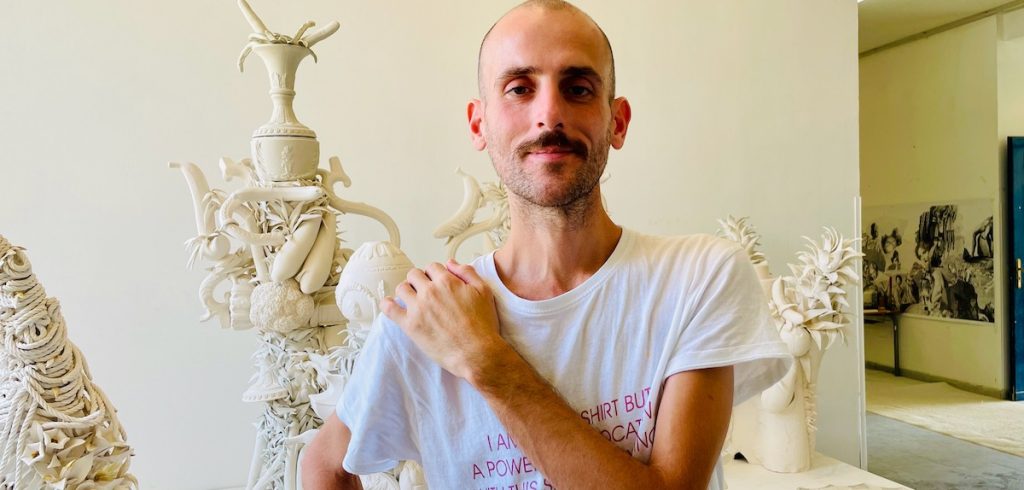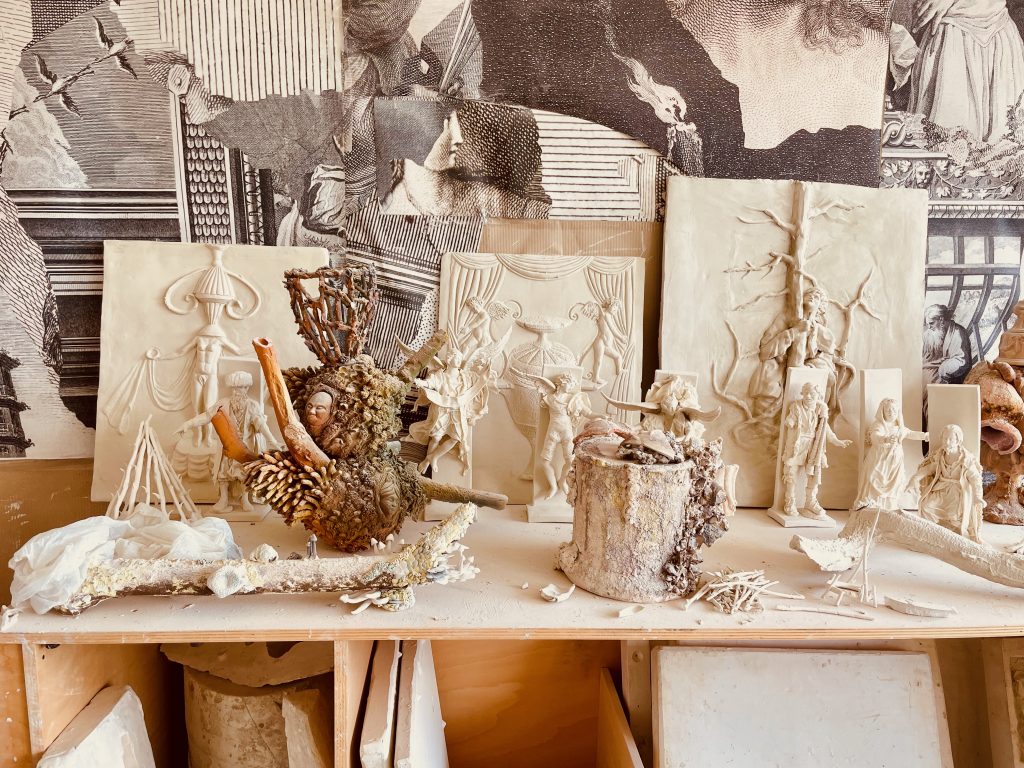A kind of highway on the outward journey, the winding ups and downs emerging behind the Capodimonte Wood on the way back: Scampia is a sunny enclave, dotted with futuristic architecture – bunches of brutalist buildings surrounded by very large spaces.
A chess game between empty and full, dead ends, hyper-modern sanctuaries, concrete, steel and large arteries. A few kilometers from the hilly historic center of Naples and yet another world.
I had been missing the district since 2008 when I wrote a temporary architecture tabloid on Naples together with Volume magazine (Amsterdam) with the help of an equally temporary editorial staff. Which ended together with many other projects of a research on the Neapolitan suburbs in a museum recently opened in those years, the Madre.
I went back to interview a dear friend from university days, Giovanni Zoppoli who made Scampia the epicenter of his Mammut network dedicated to alternative pedagogy and mobile libraries.
This time I visit Diego Cibelli, I had only known his creation last year through a wonderful concept of reinterpreting some historical pieces at the Capodimonte National Museum.
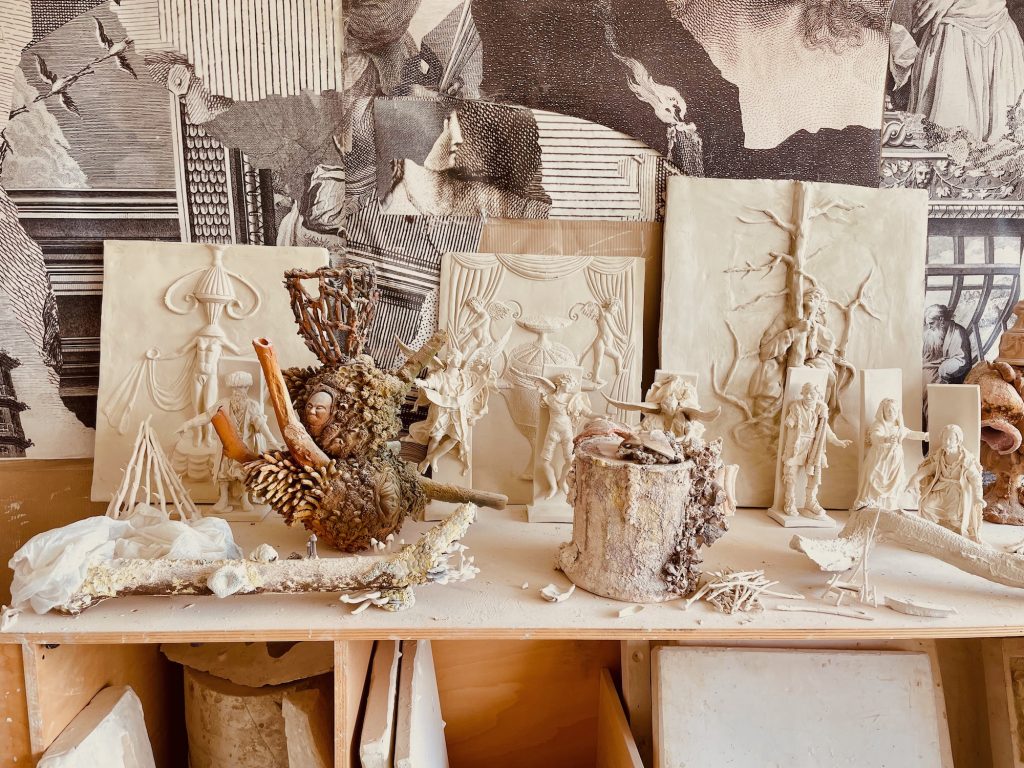
He is at home here, in the sense that he was born in Scampia, he never stopped producing in the neighborhood with a large atelier (occupying half of a school complex that is still functioning) even though he lived ten years in Germany.
I arrive immediately after the crates of some impressive works have left for New York, where the artist exhibits at The Armory Show, I admire the studio copies. About Capodimonte, which closes shortly to be deeply restored; the charismatic director Sylvain Bellenger asked him to design the new bar, including the furnishings.
Almost 40 degrees are dazzling outside, while inside everything is rarefied by the patina of kaolin and quartz: they pass me a glass of frozen water and I suddenly scroll through the rooms where I see many hard-working hands and minds at work – all young Diego’s collaborators.
The first thing they tell you is that they look very good here.
They all have the same t-shirts, a gift from Giuseppe for Diego’s birthday who recently exhibited in a well-known Neapolitan art gallery with just two months’ notice, preparing an exceptional exhibition where we then physically met for the first time. The birthday gift is an echo of that creative marathon.
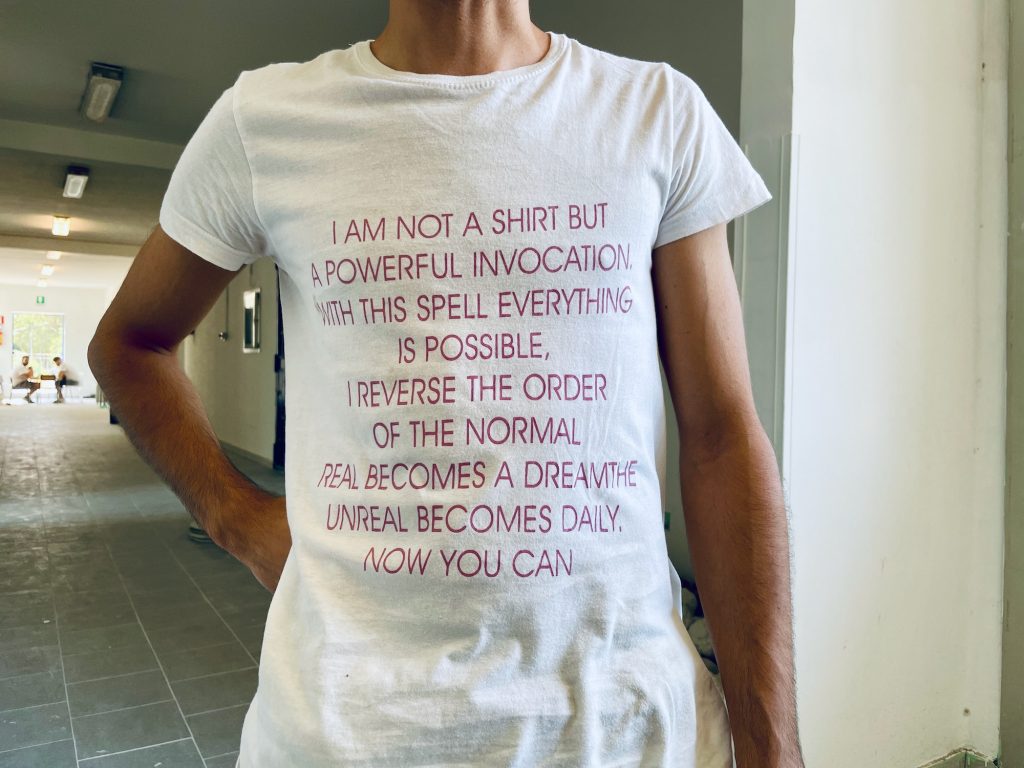
Giuseppe, 22 years old: ‘We have known each other for a while, our working relationship has been growing over time, I have been working here more assiduously for about two years. I am a little younger than Diego. We met when I was at the Royal Factory of Capodimonte as a student of him, at 17. I also experienced Diego’s creative side. What characterizes it most is the fluidity of the project and our degree of involvement in all phases, including the creative one.
Some things are not explained, they are scrolled; are unspeakable. Practice and theory are well assimilated here, there is a strange potion in mixing conceptualization, design, construction, the way in which we start all over again, throwing everything away and then, of course, the rules of ceramics rule! A back and forth between practice and project ‘.
Like dance, I think: especially like the contact improvisation. Diego Cibelli expands equally between sculpture, art, ceramics, textiles, design; his practice is so rich in stimuli, references and design cultures that it avoids any categorization.
The artist explains that he does not work for ‘mandates’ or for specific requests but for production cycles that follow one another.
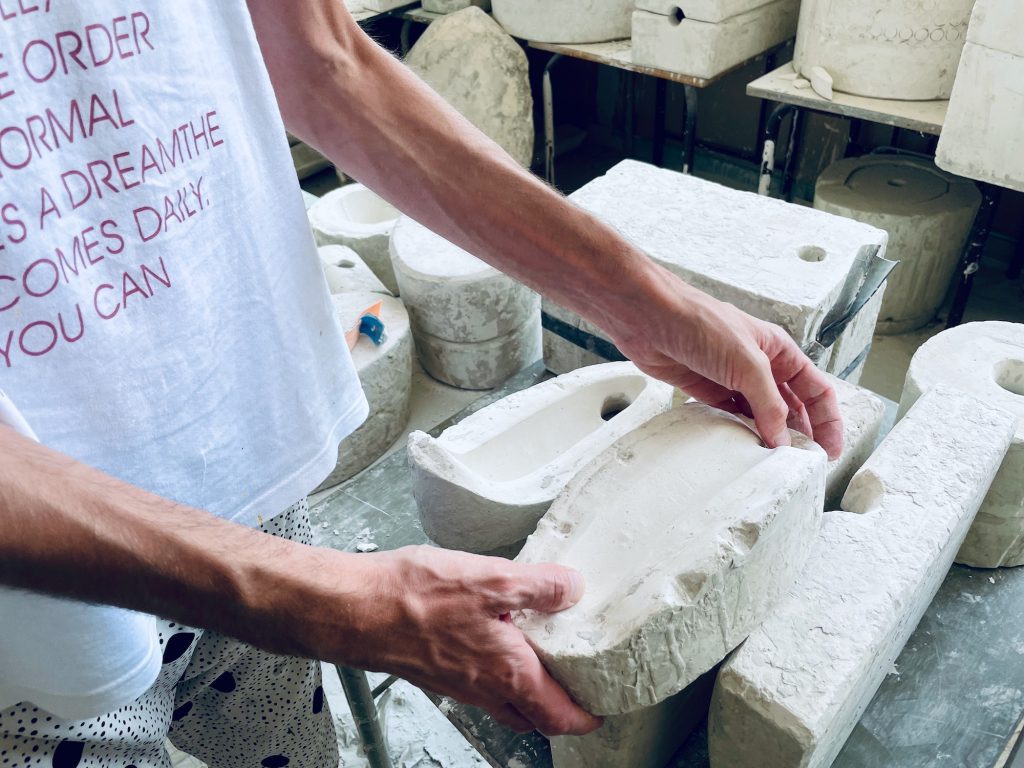
He hardly starts a job because he was asked: he is interested in doing artistic research tout court that finds its place in specific exhibitions.
This allows him to produce even in a short time: he does not ‘open a book to write about something’ but from time to time he shows what he is at at that moment.
He has a continuous relationship with the material and often a reference, a scenario or a visit to the exhibition sites is enough for him to prepare a gigantic and extraordinary exhibition without a single drawing, as was the case with the one by Alfonso Artiaco.
Dedicated to the Neapolitan festivals of the XVIII Cent,, marked by a protocol for each activity of the days of the Bacchanalia: fireworks, medieval games around the obelisks, the triumphs (magnificent banquets designed by architects), the gift of food to the people, allegorical floats.
Cibelli adores the richness of Naples, its stratification: it is something that has no equal in the world (and while he tells it his eyes shine with a deep light).
‘When friends from outside come they wonder how we can dialogue with this immense heritage and with this matrix that they fear could be suffocating them: in my case I explain that it is not.
Even when I was little, in elementary school I used to make always ‘filone’ (forca, bigiare: each Italian region has a different way of meaning ‘skipping school’), I needed constant contact with this beauty and I remember that I often went to Port’Alba and I would go into some bookstore to read all morning, actually I was looking at art history books.’
Raise me a curiosity, but how did you do it in elementary school?
I was a street urchin (the word scugnizzo is untranslatable, from many senses it has: one out of many, a boy free to be on the street)
When were you born?
In 1987.
Other friends from the world of art come from Scampia, such as Eugenio Viola, are you friends?
Yes, we attended especially when he curated the exhibitions at the Madre museum. My mission is to do artistic research, I don’t deal with social issues.
Don’t you even take care of training young people?
No, many young people have asked me to work with me attracted by my type of research, by my way of transforming matter into vision, I have no pedagogical intent. In general, I have few goals in life: to work, to research. If some are added, such as the request to work with me, I don’t check them but obviously I welcome them.
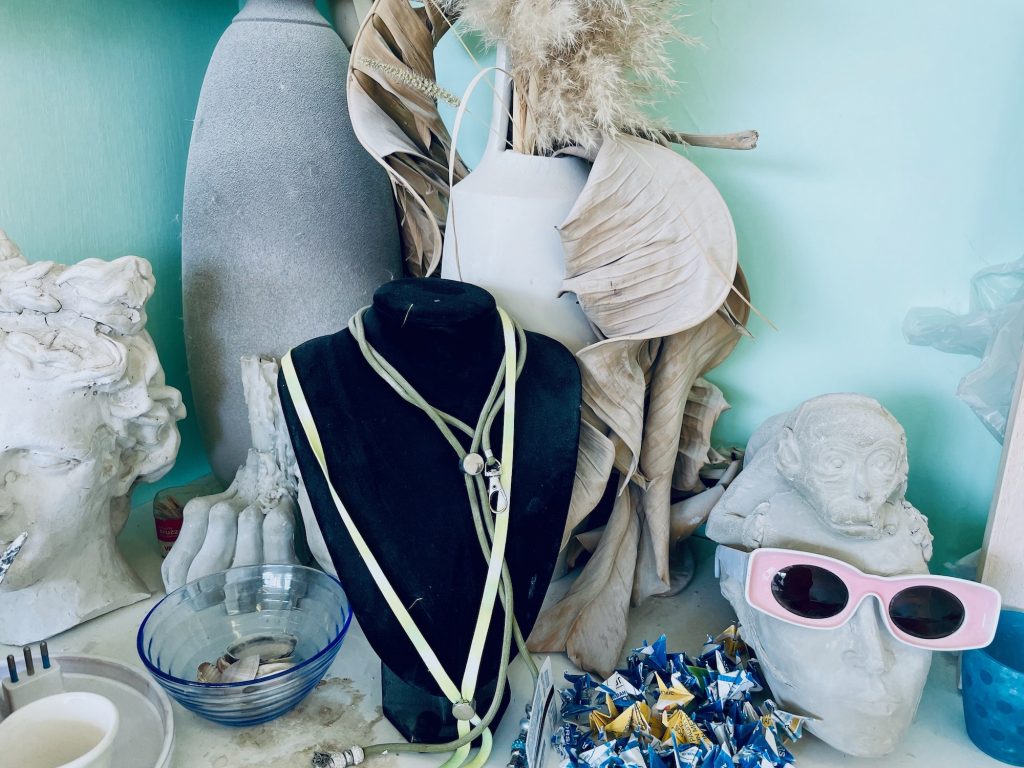
Your life in a few words
I was born here, the youngest of four children. A very introverted child, I loved having eccentric clothes and it was very difficult for me to distinguish the male ones from the female ones. At that time it was very difficult to walk here dressed so differently. I didn’t think I would attract so much attention to the clothes I wore because as a child they were toys for me.
My outfits were very important at least for me: they made me have fun, they set the tone for the day. I was very keen and prepared them with care.
Even now you are like that
Yes I still like to think of clothes as toys. Going back to my childhood, I spent a lot of time alone and it allowed me to manage my days with immense freedom. It is magnificent, you know? Of all the good things that have happened to me this year, I still think that the most magnificent part is how I managed to cultivate my freedom, it gives me a lot of strength.
It is not easy when you decide to do this profession, the answers are never immediate and you have to be able to rely a lot on yourself. Especially when you are young, but the sense of freedom is my strength to keep going.
I didn’t want to go to school, just to avoid too much attention on myself. My teachers didn’t understand me. My first references were born later, in middle school: a very tough and severe professor of art history, I liked his way of provoking me and questioned me a lot. I loved his complexity, he went straight to the substance, to the truth: and this helped me a lot.
Do you think he came to some of your shows, perhaps incognito?
I have lost sight of him. Most of my time as a kid I spent reading books and I didn’t think Paris, London existed. I learned geography later. I asked where the paintings I loved were, that’s when geography was born for me and over the years I asked my parents to go and see them.
My family, very very humble, followed me a lot. My father who came after the war suffered hunger but he allowed me on everything and supported a lot my travels. I don’t know if they really understood what I was doing but they always embraced my need to look at what was outside Naples with curiosity. Even as a child, I traveled extensively.
I did not think of becoming an artist and yet I went to see museums everywhere even in Italy (Florence, Rome) to look for those works that I admired in my long mornings as a student: in front of that beauty I never felt small, I was never afraid. I always felt like I was dancing. I tried to keep this energy in me, even today.
I then, gradually, approached art studies: first the artistic high school, then the studies in fashion, the fine art academy in Berlin, product design.
How did you find the art scene in that city?
Beautiful even though I didn’t like the cut. I have always worked with richness and cornucopia while the Teutonic artistic cut is minimal.
What fascinates me about Berlin is its cultural agenda, its wealth of events and musical scenes. I like to experience. I like to expose myself to all the things that happen.
In Berlin I was immediately attracted to galleries interested in installations; I like to produce the object and its entire context, I like to produce an environment.
The pattern and the environment in which you are immersed: do you print and design your fabrics or do you have collaborations?
With textiles as with porcelain, I am interested in getting to the material only after I have worked on the scenery. And for this I feed on references, references that inebriate me and then I step on the production.
Also for the Capodimonte museum lounge bar: we will soon photograph all the textiles in the collection and compose some wallpapers.
In Meditation in Emergency project, a production born during the lockdown, I worked on textiles creating a hypothetical scenario (of closure, of lack of contact) and all the prints were reproduced on warm fabrics, such as plaids, similar to works presented at the Morra Greco Foundation.
I like to be generous: I don’t define myself as a sculptor or anything else. I work in the visual culture which is like a motor activity, it never stops. I like to think of the image of a hypothetical runner, like in sports.
I don’t go into the individual ‘departments’ of making, I like to embrace them all. I like to think about the fabric, the relationship with the photo and the video. I celebrate all the visual culture.
You studied design in Naples, you went to the Academy in Berlin and you took possession of this place. Have you always thought it was the right workshop for you?
Yes, since day 1. Since I saw it. I have always kept it, I already had it when I was studying in Berlin where I always did everything to integrate and have meaningful relationships but I knew I would come back here.
Did you have exhibitions in Berlin? Could you also produce there?
Yes, at Bethanien (a Kreutzberg kunstraum) and I could also produce in the city. I have had other significant experiences of exhibitions in Berlin.
When you told me that you experienced emptiness and loneliness, growing in it and not being afraid, I think that there you tempered yourself to then easily manage relationships with different museums, galleries and foundations at the same time.
You have worked with very important galleries – I am also thinking, for example, of the Villanova Gallery, which in Italy has a very precise research that embraces limited editions, jewelry, ceramics. A design completely fused with art.
Haven’t you ever felt friction between all these worlds?
I feel very comfortable because I always choose to work with people who have a human model that interests me.
I don’t know if it is luck or an orientation inherent in me: I have never had bad experiences with all the people I met for work.
Antonella Villanova has an extraordinary humanity, the same is Alfonso Artiaco who has an extreme passion as well as being a workaholic.
I want to work with people who have passion and who know what they are doing, in the world of art there is a lot of self-centeredness. It is something that demeans and gives inconsistency, I like to be concrete. Power and self-centeredness have never interested me. I repeat, I do not know if it is luck or predisposition but I always meet people with whom I make excellent alliances.
And a person as enlightened as the director of Capodimonte Sylvain Bellenger?
He really made a difference. He and Attorney Charre. They made a difference in the sense of staying here in Naples. They opened that door that I have always wanted, to beauty or infinity.
The dialogues, the advice, what to watch, what to reflect: I see Bellenger as eternal. His choices will still serve to come.
I met the lawyer Jean Nouvel Charre here in Naples: he is like me, a child who surrounds himself with beautiful things and always advises me for the best. When I am in a phase of creation I always ask him for some references: it is the human library that I am looking for. He knows everything about me, he provides me with visual material that immediately turns me on. It is my baking power.
For you, ceramics and porcelain are the main example of human geography that remains central to you as a paramount concept: a lot of work, many hands, a lot of passion, mineral roots. And finally, the very essence of a material, which binds very much. It needs a lot of creative and material energy to form.
You love travel and movement, it is not easy to travel light with this stylistic and technical choice. How do you reconcile these apparent oxymorons?
It is very complex, take The Armory Show for example: moving this installation was not at all simple but it is done. It does everything.
There is never really a limit to things, also because nothing is simple.
All in all, complex things are also the simplest ones because they come from the ethics of doing. If you respect the work and its size, you find simplicity in everything.
In my opinion, your relationship with the Royal Factory of Capodimonte was the only place that could really welcome you for your return to the city. The excellence you were looking for.
Thanks to Alessandra Troncone, I had the proposal to apply to a tender for an exhibition in the bathrooms of Porta Venezia. My works were on show together with those of the Turkish videomaker Ali Kazma. We were in 2019, later we have also applied for the SIAE Call which we have also won and we have done other projects with the Real Fabbrica, always guided by this enlightened curator.
You always have great fellow travelers then!
Absolutely.
Since you were a book binge eater as a child, where do you find the time to read today if you find it and what do you read?
When I was studying product design, I often attended Colonial and Post Colonial Studies (a department of the Oriental University of Naples, where Iain Chambers and Tiziana Terranova can be found and listened to) for their round tables.
I always feel exposed to a continuous transformation not only in books but everywhere, I never see that things wear out and, above all, I no longer see difficulties in reconciling study, reading, research and production. Everything lives together beautifully.
If we want to try a definition of balance, this is the perfect osmosis of all these partitions (which I have finally achieved).
Reading is always combined with metamorphosis, restitution. And, again, everything lives together.
And a book that you have now on your nightstand?
Yoko Ono’s Grape Fruit.
Your relationship with music? What have you been listening to recently?
Music is always with me, the only thing I do to get rid of the flow of work at the end of the day is listening to music here in Scampia, near the Vele (a building complex by architect Franz di Salvo, starring character of Gomorra, the movie): I walk around 10 kilometers at night, I relax and dance, I love to dance. I walk and dance. Here it is safe, you can afford to do this at night, there are always people around.
What have you learned and understood from this life?
Two things. Making informed choices about myself to stay free. Meeting the right people, who have given me so much: this gives concreteness.
Have you ever thought about designing your own line of clothes?
I never thought about it. It would be nice!
What if someone out there asks you that?
I would definitely say yes!
#diegocibelli
#sylvainbellenger
#thearmoryshow
#alfonsoartiaco
#galleriavillanova
#museoerealboscodicapodimonte
#realfabbricadicapodimonte
